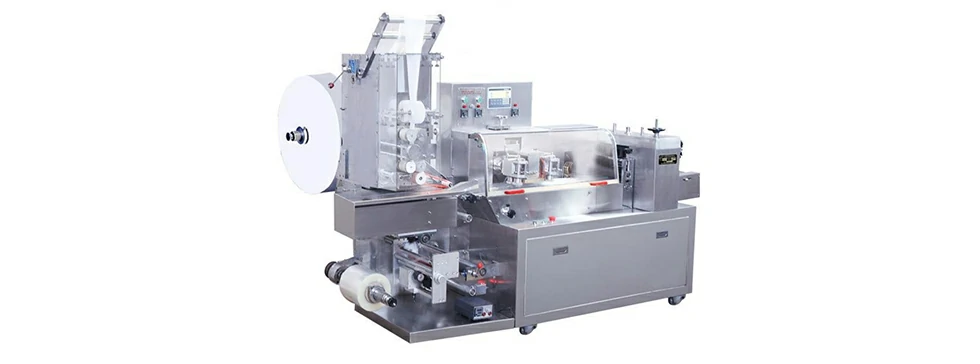Identifying leaks or fluid-related issues in single wet wipes packing machines involves systematic inspection and observation.
Here’s a step-by-step guide:
- Visual Inspection: Start with a visual examination of the machine, focusing on areas where fluids are used or circulated. Look for signs of dampness, discoloration, or pooling fluids.
- Inspect Fluid Lines and Connections: Check all fluid lines, hoses, connectors, and fittings for signs of leaks, cracks, or loose connections. Look for dampness, drips, or stains around these areas.
- Fluid Reservoirs and Tanks: Examine fluid reservoirs or tanks for any visible leaks, overflow, or irregularities in fluid levels. Pay attention to seals and gaskets around these components.
- Pressure or Flow Issues: Monitor pressure gauges or indicators associated with fluid systems. A sudden drop in pressure or irregular flow patterns might indicate leaks or blockages.
- Fluid Sensors and Detectors: If the machine is equipped with sensors or detectors for fluid levels or leaks, check their readings or indicators for any abnormalities.
- Inspect Seals and Gaskets: Inspect seals and gaskets in pumps, valves, or other fluid-handling components. Damaged or worn-out seals can lead to leaks.
- Check for Accumulated Residue: Look for residue buildup around seals, joints, or connections. Accumulated residue can indicate previous leaks or ongoing issues.
- Operational Observations: While the machine is in operation, observe for any unexpected drips, spurts, or changes in fluid behavior that might indicate leaks or irregularities.
- Use Leak Detection Solutions: Employ leak detection solutions or dyes designed for identifying leaks in fluid systems. These solutions change color upon contact with leaking fluids, making leaks more visible.
- Documentation and Record-Keeping: Document any observations, findings, or suspected areas of concern. Record details such as location, severity, and type of fluid involved.
- Consult Manufacturer Guidelines: Refer to the manufacturer’s maintenance manual or guidelines for specific checks or indicators related to fluid systems in the machine.
- Schedule Regular Inspections: Incorporate routine inspections of fluid systems into the machine’s maintenance schedule to detect and address potential issues early.
By conducting thorough inspections, monitoring fluid-related indicators, and leveraging specialized detection methods where needed, you can identify leaks or fluid-related issues in single wet wipes packing machines. Timely detection and addressing these issues can prevent downtime and maintain the machine’s efficiency.
How does wear on moving parts impact the overall performance of the single wet wipes packing machine?
Wear on moving parts in a single wet wipes packing machine can significantly impact its overall performance in several ways:
- Reduced Efficiency: Wear on moving parts can lead to decreased efficiency as components lose their precision or become misaligned. This can slow down the packaging process, affecting production output.
- Increased Downtime: As wear progresses, the likelihood of breakdowns or malfunctions increases. single wet wipes packing machine This can result in unplanned downtime for repairs, affecting the machine’s availability for production.
- Quality Issues: Wear on moving parts can cause inconsistencies in sealing, cutting, or packaging, leading to variations in product quality. This might result in improperly sealed or packaged wet wipes.
- Higher Maintenance Costs: Increased wear often necessitates more frequent maintenance or replacement of components, leading to higher maintenance costs and a greater need for spare parts.
- Safety Concerns: Wear on critical moving parts can pose safety risks. Loose or misaligned components might lead to accidents or injuries for machine operators if not addressed promptly.
- Energy Consumption: Worn parts might require more energy to function properly, leading to increased energy consumption and operational costs.
- Loss of Tolerance: Wear can cause a loss of tolerance in moving parts, affecting their ability to perform with the required precision. This loss of tolerance can compromise the overall integrity of the machine.
- Unplanned Downtime: Sudden failures due to wear on critical components can lead to unplanned downtime, disrupting production schedules and causing delays in delivery.
- Long-Term Damage: If wear is left unaddressed, it can lead to more significant damage to other parts of the machine, exacerbating the issue and potentially requiring extensive repairs or replacements.
- Effect on Other Components: Wear on one moving part can impact the performance of interconnected components, leading to a domino effect where multiple parts are affected.
Regular maintenance, timely replacement of worn parts, and proactive monitoring can help mitigate the impact of wear on moving parts in a single wet wipes packing machine. This ensures optimal performance, maintains product quality, and minimizes downtime.
